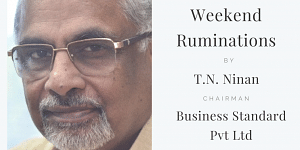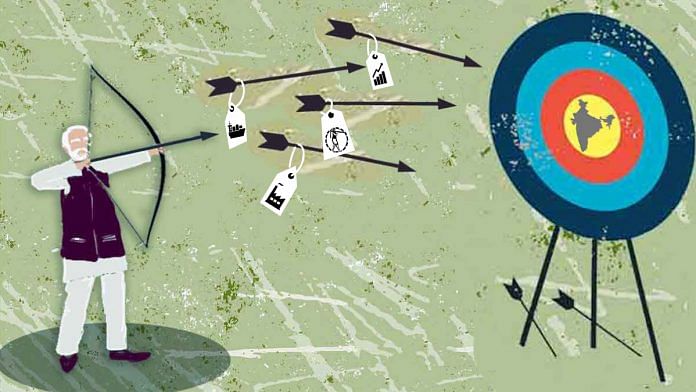The Modi government does not make life easy for itself when it sets ambitious targets that most people would consider unachievable. Among them: Taking up the share of manufacturing in GDP from 17 per cent now to 25 per cent by 2022; doubling farmers’ incomes, also by 2022; doubling exports by 2025; and of course, getting GDP from $2.7 trillion (approx. Rs 186 lakh crore) last year to $5 trillion (approx Rs 344 lakh crore) by 2025 (implying 8 per cent average annual growth on the back of 4 per cent inflation).
The government is doubtless encouraged in its ambitions by the fact that it has managed enormous progress on, if not quite achieved, some other stretch targets — to do with cooking gas availability, highway construction, renewable power, banking inclusion, and ending open defecation.
 But it is one thing to achieve specific targets, like building toilets (concentrating effort and resources, combined with dedicated project leadership, can deliver a lot). And quite another to deliver on ambitious macro-economic goals that require a loosely-controlled system to coordinate phased action within tight deadlines and the right policy framework. The government has been good on the first, not-so-good on the second.
But it is one thing to achieve specific targets, like building toilets (concentrating effort and resources, combined with dedicated project leadership, can deliver a lot). And quite another to deliver on ambitious macro-economic goals that require a loosely-controlled system to coordinate phased action within tight deadlines and the right policy framework. The government has been good on the first, not-so-good on the second.
Take export growth, which in the last five years has been all of 5 per cent. What kind of changes and effort will it take to deliver 100 per cent growth in the next six, when the global trading environment has deteriorated? Manufacturing as a share of GDP has been stagnant through the life of the first Modi government (other than the change in share that followed the re-jigging of GDP numbers), so why should one expect a 50 per cent increase in share in the next few years? As for doubling farmers’ incomes, the government simply does not have the policy tools and the financial wherewithal to deliver.
Also read: Govt should ensure health of banks doesn’t depend on who owns them
Some of the unreal goal-setting dates back a few years, and is possibly of a piece with the foolish talk in the initial years of the first Modi government that GDP growth would soon be in double digits. In today’s more realistic mood, even if one sets aside the issues raised by Arvind Subramanian and accepts the GDP numbers as officially recorded, growth has dropped to an average of 7 per cent in the last couple of years. Most forecasts say (somewhat optimistically) that growth will stay at or around that level this year and the next. If the goal of $5 trillion by 2024-25 is taken seriously, subsequent GDP growth will have to accelerate to an average of 8.5 per cent — something that hasn’t happened since the 2008 financial crisis. Those daunted by this could argue that little is lost with a year’s slippage in reaching the target. But then it would be as P Chidambaram said: A mere compounding of the existing growth rate.
The real issue is the direction of government policy. On protectionism and tariff policy, for instance, it is moving in the direction exactly opposite to that recommended by the High Level Advisory Group on exports. Some labour law issues are being addressed through the two labour codes that have been finalised; the core issue of delivering a more flexible labour market remains only partially addressed. And little has been done to achieve greater integration with global supply chains.
That the path ahead won’t be smooth becomes clear from the report last December by the Logistics Advisory Committee of the Economic Advisory Council to the Prime Minister. This spells out the formidable infrastructure constraints and costs imposed on exporters from India, compared to their counterparts in other countries. Port logistics (including shipping) impose an additional cost equal to 7-8 per cent of consignment value, which is crippling enough. Other costs are high, too: Transport, capital, electricity. Much work remains to be done to simplify and streamline procedures and documentation.
It is early days in the new government’s life. While there is talk of 100-day action plans, it is known that the prime minister prefers sustained incrementalism to a big-bang approach. Still, his government will need to show greater purpose quickly if the macro targets set out are not to become embarrassments.
By Special Arrangement with Business Standard
Also read: India is running out of time to capitalise on its demographic dividend




Modi’s intentions are good – but they do not have expertise to deliver. Unfortunately the government suffers from poverty of ideas. But all the goals set out have political connotations and not economic substance. People will vote for Modi because he speaks big.
a k pattabiraman, Chennai
Such goals are called stretch goals in corporate speak.
They are not meant to be necessarily achieved but coming within a distance of them is also considered some kind of achievement.
Modi likely understands the indian psyche, both the workers and the voters. His bet is that even partially achieved stretch goals would be politically palatable to the electorate
One is subject to correction, but the cushion of 4% inflation, added to 8% real growth, is not available to take us to $ 5 trillion in five years. That would have been the case if the GDP target was expressed in rupees. The dollar is a mighty beast, has always strengthened against the rupee, adding to the gradient not lessening it. 2. At the present rate of climb, it will take fifty years to double farmers’ incomes., not the promised five. Of the many tasks the government performs, creating an economic miracle is the least amenable to spin and a sustained PR campaign.
An excellent article. Food for thought for the government to ponder. It is said that a leader of a team has to be sufficiently ambitious so that the team can excel in its performance beyond expectations. However, setting over-ambitious targets could be counterproductive.